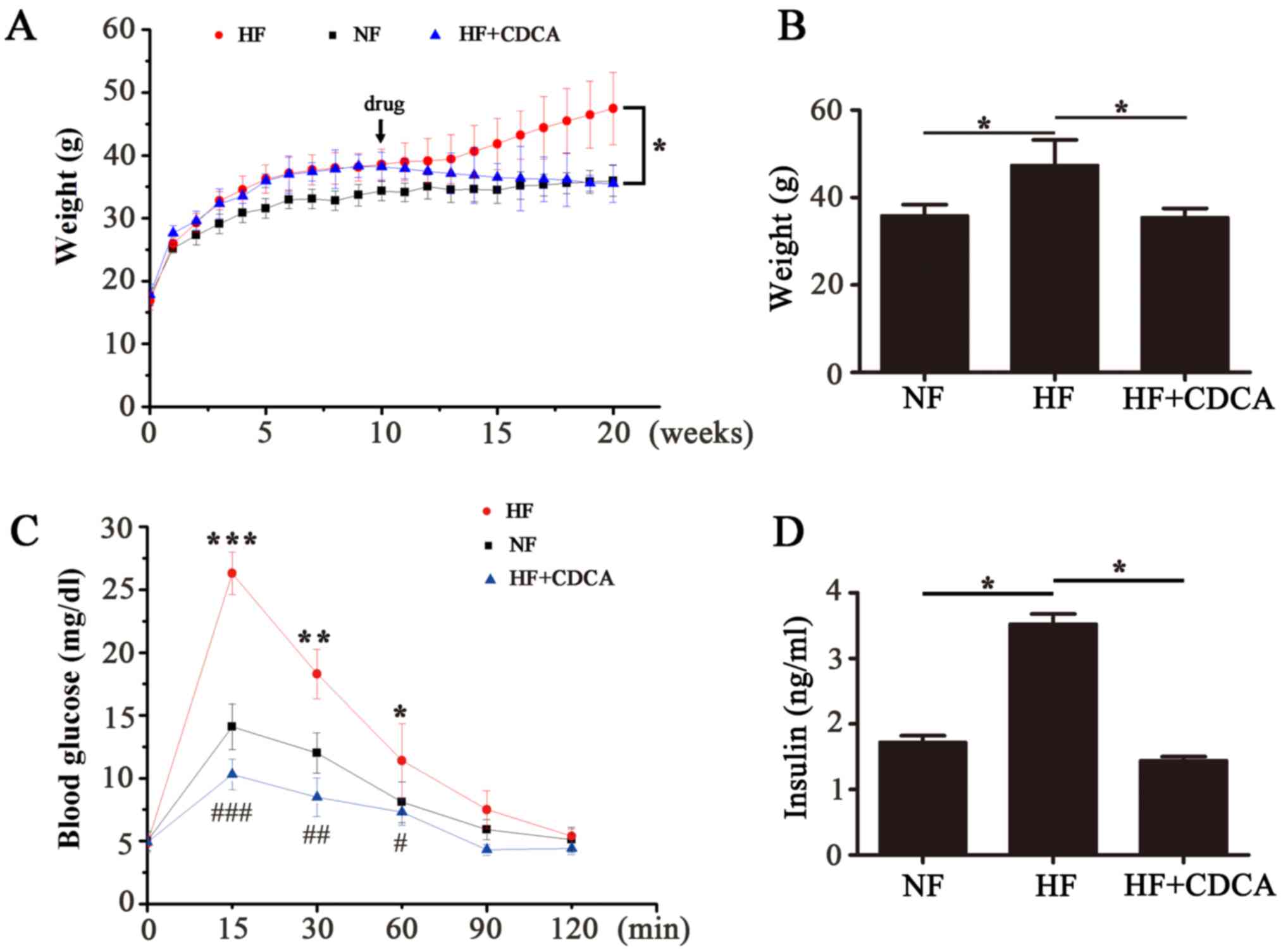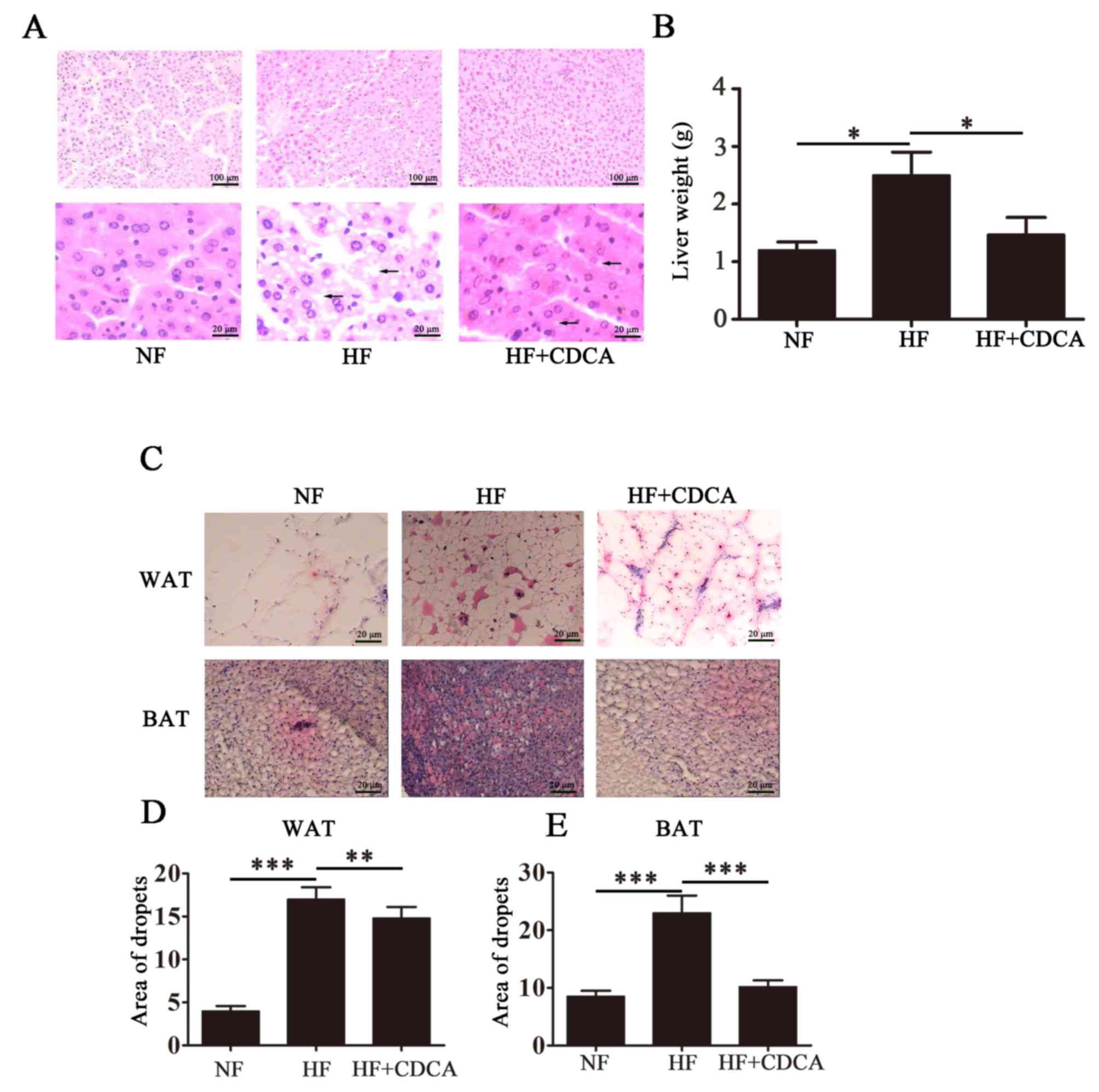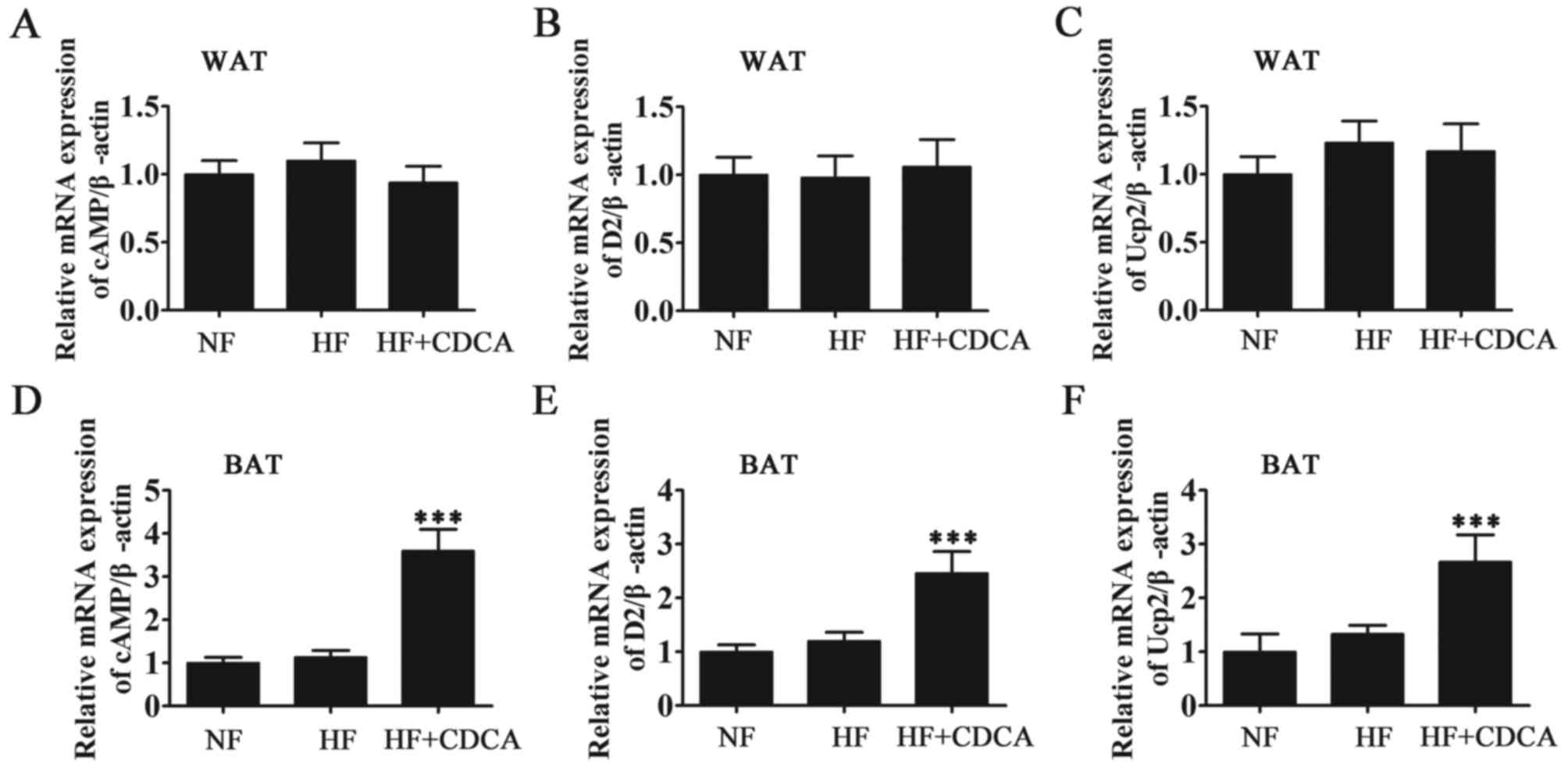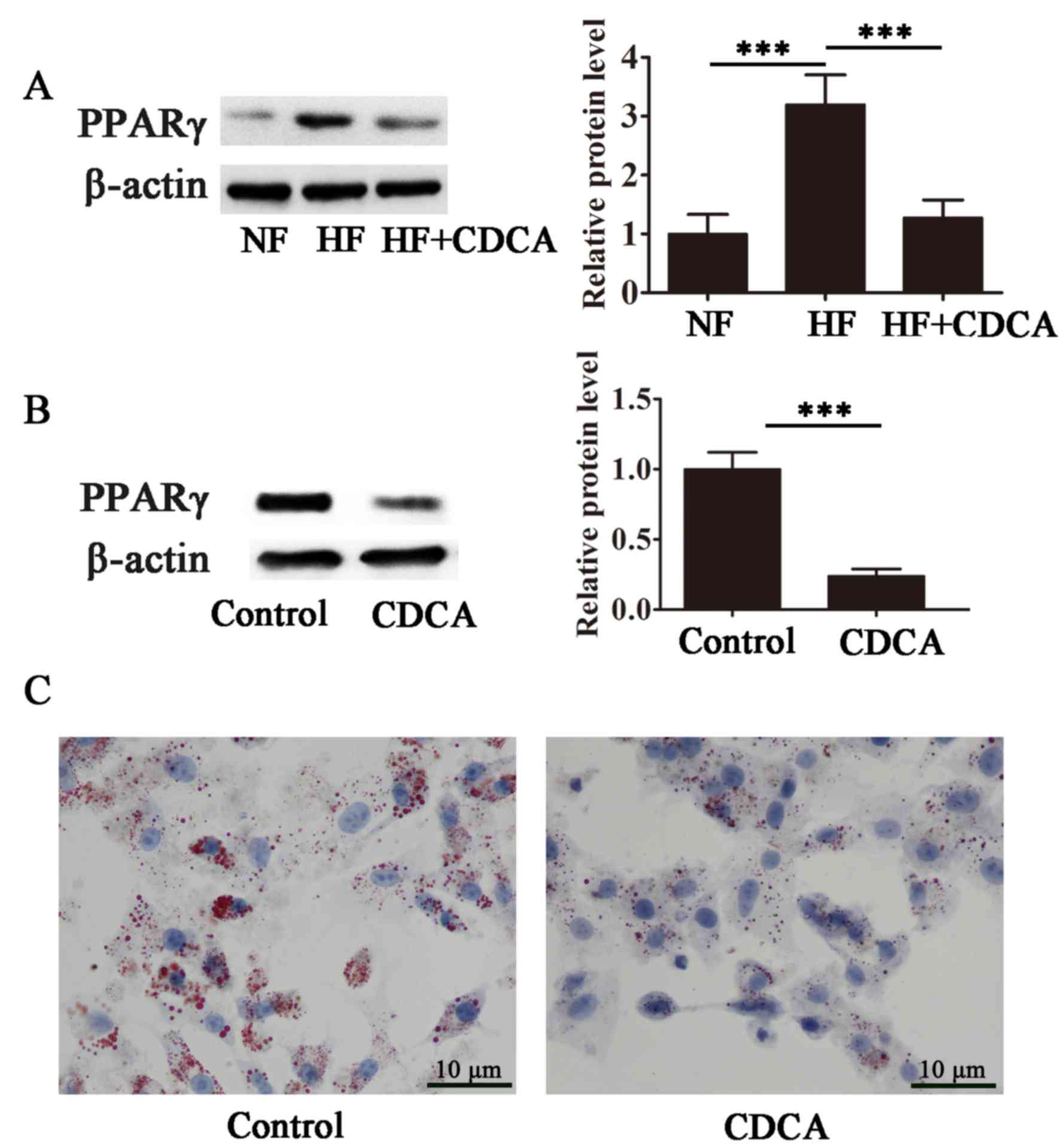|
1
|
Hossain P, Kawar B and El Nahas M: Obesity
and diabetes in the developing world-a growing challenge. N Engl J
Med. 356:213–215. 2007. View Article : Google Scholar : PubMed/NCBI
|
|
2
|
Gesta S, Tseng YH and Kahn CR:
Developmental origin of fat: Tracking obesity to its source. Cell.
131:242–256. 2007. View Article : Google Scholar : PubMed/NCBI
|
|
3
|
Alrushud AS, Rushton AB, Kanavaki AM and
Greig CA: Effect of physical activity and dietary restriction
interventions on weight loss and the musculoskeletal function of
overweight and obese older adults with knee osteoarthritis: A
systematic review and mixed method data synthesis. BMJ Open.
7:e0145372017. View Article : Google Scholar : PubMed/NCBI
|
|
4
|
Onakpoya IJ, Heneghan CJ and Aronson JK:
Post-marketing withdrawal of anti-obesity medicinal products
because of adverse drug reactions: A systematic review. BMC Med.
14:1912016. View Article : Google Scholar : PubMed/NCBI
|
|
5
|
Liu P, Ji Y, Yuen T, Rendina-Ruedy E,
DeMambro VE, Dhawan S, Abu-Amer W, Izadmehr S, Zhou B, Shin AC, et
al: Blocking FSH induces thermogenic adipose tissue and reduces
body fat. Nature. 546:107–112. 2017. View Article : Google Scholar : PubMed/NCBI
|
|
6
|
Townsend K and Tseng YH: Brown adipose
tissue: Recent insights into development, metabolic function and
therapeutic potential. Adipocyte. 1:13–24. 2012. View Article : Google Scholar : PubMed/NCBI
|
|
7
|
Cypess AM and Kahn CR: Brown fat as a
therapy for obesity and diabetes. Curr Opin Endocrinol Diabetes
Obes. 17:143–149. 2010. View Article : Google Scholar : PubMed/NCBI
|
|
8
|
Saito M, Okamatsu-Ogura Y, Matsushita M,
Watanabe K, Yoneshiro T, Nio-Kobayashi J, Iwanaga T, Miyagawa M,
Kameya T, Nakada K, et al: High incidence of metabolically active
brown adipose tissue in healthy adult humans: Effects of cold
exposure and adiposity. Diabetes. 58:1526–1531. 2009. View Article : Google Scholar : PubMed/NCBI
|
|
9
|
van Marken Lichtenbelt WD, Vanhommerig JW,
Smulders NM, Drossaerts JM, Kemerink GJ, Bouvy ND, Schrauwen P and
Teule GJ: Cold-activated brown adipose tissue in healthy men. N
Engl J Med. 360:1500–1508. 2009. View Article : Google Scholar : PubMed/NCBI
|
|
10
|
Virtanen KA, Lidell ME, Orava J, Heglind
M, Westergren R, Niemi T, Taittonen M, Laine J, Savisto NJ,
Enerback S, et al: Functional brown adipose tissue in healthy
adults. N Engl J Med. 360:1518–1525. 2009. View Article : Google Scholar : PubMed/NCBI
|
|
11
|
Zingaretti MC, Crosta F, Vitali A,
Guerrieri M, Frontini A, Cannon B, Nedergaard J and Cinti S: The
presence of UCP1 demonstrates that metabolically active adipose
tissue in the neck of adult humans truly represents brown adipose
tissue. FASEB J. 23:3113–3120. 2009. View Article : Google Scholar : PubMed/NCBI
|
|
12
|
Cannon B and Nedergaard J: Brown adipose
tissue: Function and physiological significance. Physiol Rev.
84:277–359. 2004. View Article : Google Scholar : PubMed/NCBI
|
|
13
|
Beranger GE, Karbiener M, Barquissau V,
Pisani DF, Scheideler M, Langin D and Amri EZ: In vitro brown and
‘brite’/‘beige’ adipogenesis: Human cellular models and molecular
aspects. Biochim Biophys Acta. 1831:905–914. 2013. View Article : Google Scholar : PubMed/NCBI
|
|
14
|
Rubattu S, Stanzione R, Bianchi F, Cotugno
M, Forte M, Della Ragione F, Fioriniello S, D'Esposito M, Marchitti
S, Madonna M, et al: Reduced brain UCP2 expression mediated by
microRNA-503 contributes to increased stroke susceptibility in the
high-salt fed stroke-prone spontaneously hypertensive rat. Cell
Death Dis. 8:e28912017. View Article : Google Scholar : PubMed/NCBI
|
|
15
|
Rothwell NJ and Stock MJ:
Luxuskonsumption, diet-induced thermogenesis and brown fat: The
case in favour. Clin Sci (Lond). 64:19–23. 1983. View Article : Google Scholar : PubMed/NCBI
|
|
16
|
Arch JR: beta(3)-Adrenoceptor agonists:
Potential, pitfalls and progress. Eur J Pharmacol. 440:99–107.
2002. View Article : Google Scholar : PubMed/NCBI
|
|
17
|
Ghorbani M and Himms-Hagen J: Appearance
of brown adipocytes in white adipose tissue during CL 316,
243-induced reversal of obesity and diabetes in Zucker fa/fa rats.
Int J Obes Relat Metab Disord. 21:465–475. 1997. View Article : Google Scholar : PubMed/NCBI
|
|
18
|
Kim H, Pennisi PA, Gavrilova O, Pack S,
Jou W, Setser-Portas J, East-Palmer J, Tang Y, Manganiello VC and
Leroith D: Effect of adipocyte beta3-adrenergic receptor activation
on the type 2 diabetic MKR mice. Am J Physiol Endocrinol Metab.
290:E1227–E1236. 2006. View Article : Google Scholar : PubMed/NCBI
|
|
19
|
Kopecky J, Clarke G, Enerback S,
Spiegelman B and Kozak LP: Expression of the mitochondrial
uncoupling protein gene from the aP2 gene promoter prevents genetic
obesity. J Clin Invest. 96:2914–2923. 1995. View Article : Google Scholar : PubMed/NCBI
|
|
20
|
Nagase I, Yoshida T, Kumamoto K, Umekawa
T, Sakane N, Nikami H, Kawada T and Saito M: Expression of
uncoupling protein in skeletal muscle and white fat of obese mice
treated with thermogenic beta 3-adrenergic agonist. J Clin Invest.
97:2898–2904. 1996. View Article : Google Scholar : PubMed/NCBI
|
|
21
|
Liu X, Zheng Z, Zhu X, Meng M, Li L, Shen
Y, Chi Q, Wang D, Zhang Z, Li C, et al: Brown adipose tissue
transplantation improves whole-body energy metabolism. Cell Res.
23:851–854. 2013. View Article : Google Scholar : PubMed/NCBI
|
|
22
|
Stanford KI, Middelbeek RJ, Townsend KL,
An D, Nygaard EB, Hitchcox KM, Markan KR, Nakano K, Hirshman MF,
Tseng YH, et al: Brown adipose tissue regulates glucose homeostasis
and insulin sensitivity. J Clin Invest. 123:215–223. 2013.
View Article : Google Scholar : PubMed/NCBI
|
|
23
|
Watanabe M, Houten SM, Mataki C,
Christoffolete MA, Kim BW, Sato H, Messaddeq N, Harney JW, Ezaki O,
Kodama T, et al: Bile acids induce energy expenditure by promoting
intracellular thyroid hormone activation. Nature. 439:484–489.
2006. View Article : Google Scholar : PubMed/NCBI
|
|
24
|
Maruyama T, Miyamoto Y, Nakamura T, Tamai
Y, Okada H, Sugiyama E, Nakamura T, Itadani H and Tanaka K:
Identification of membrane-type receptor for bile acids (M-BAR).
Biochem Biophys Res Commun. 298:714–719. 2002. View Article : Google Scholar : PubMed/NCBI
|
|
25
|
Moore DD, Kato S, Xie W, Mangelsdorf DJ,
Schmidt DR, Xiao R and Kliewer SA: International union of
pharmacology. LXII. The NR1H and NR1I receptors: Constitutive
androstane receptor, pregnene X receptor, farnesoid X receptor
alpha, farnesoid X receptor beta, liver X receptor alpha, liver X
receptor beta, and vitamin D receptor. Pharmacol Rev. 58:742–759.
2006. View Article : Google Scholar : PubMed/NCBI
|
|
26
|
Nguyen A and Bouscarel B: Bile acids and
signal transduction: Role in glucose homeostasis. Cell Signal.
20:2180–2197. 2008. View Article : Google Scholar : PubMed/NCBI
|
|
27
|
Broeders EP, Nascimento EB, Havekes B,
Brans B, Roumans KH, Tailleux A, Schaart G, Kouach M, Charton J,
Deprez B, et al: The Bile acid chenodeoxycholic acid increases
human brown adipose tissue activity. Cell Metab. 22:418–426. 2015.
View Article : Google Scholar : PubMed/NCBI
|
|
28
|
Rosen ED, Sarraf P, Troy AE, Bradwin G,
Moore K, Milstone DS, Spiegelman BM and Mortensen RM: PPAR gamma is
required for the differentiation of adipose tissue in vivo and in
vitro. Mol Cell. 4:611–617. 1999. View Article : Google Scholar : PubMed/NCBI
|
|
29
|
Hu E, Kim JB, Sarraf P and Spiegelman BM:
Inhibition of adipogenesis through MAP kinase-mediated
phosphorylation of PPARgamma. Science. 274:2100–2103. 1996.
View Article : Google Scholar : PubMed/NCBI
|
|
30
|
Chen X, Xu H, Ding L, Lou G, Liu Y, Yao Y,
Chen L, Huang W and Fu X: Identification of miR-26a as a target
gene of bile acid receptor GPBAR-1/TGR5. PLoS One. 10:e01312942015.
View Article : Google Scholar : PubMed/NCBI
|
|
31
|
Koopman R, Schaart G and Hesselink MK:
Optimisation of oil red O staining permits combination with
immunofluorescence and automated quantification of lipids.
Histochem Cell Biol. 116:63–68. 2001.PubMed/NCBI
|
|
32
|
Kawamata Y, Fujii R, Hosoya M, Harada M,
Yoshida H, Miwa M, Fukusumi S, Habata Y, Itoh T, Shintani Y, et al:
A G protein-coupled receptor responsive to bile acids. J Biol Chem.
278:9435–9440. 2003. View Article : Google Scholar : PubMed/NCBI
|
|
33
|
Chen X, Lou G, Meng Z and Huang W: TGR5: A
novel target for weight maintenance and glucose metabolism. Exp
Diabetes Res. 2011:8535012011. View Article : Google Scholar : PubMed/NCBI
|
|
34
|
Katsuma S, Hirasawa A and Tsujimoto G:
Bile acids promote glucagon-like peptide-1 secretion through TGR5
in a murine enteroendocrine cell line STC-1. Biochem Biophys Res
Commun. 329:386–390. 2005. View Article : Google Scholar : PubMed/NCBI
|
|
35
|
Sato H, Genet C, Strehle A, Thomas C,
Lobstein A, Wagner A, Mioskowski C, Auwerx J and Saladin R:
Anti-hyperglycemic activity of a TGR5 agonist isolated from Olea
europaea. Biochem Biophys Res Commun. 362:793–798. 2007. View Article : Google Scholar : PubMed/NCBI
|
|
36
|
Ye L, Jiang Y and Zuo X:
Farnesoid-X-receptor expression in monocrotaline-induced pulmonary
arterial hypertension and right heart failure. Biochem Biophys Res
Commun. 467:164–170. 2015. View Article : Google Scholar : PubMed/NCBI
|













